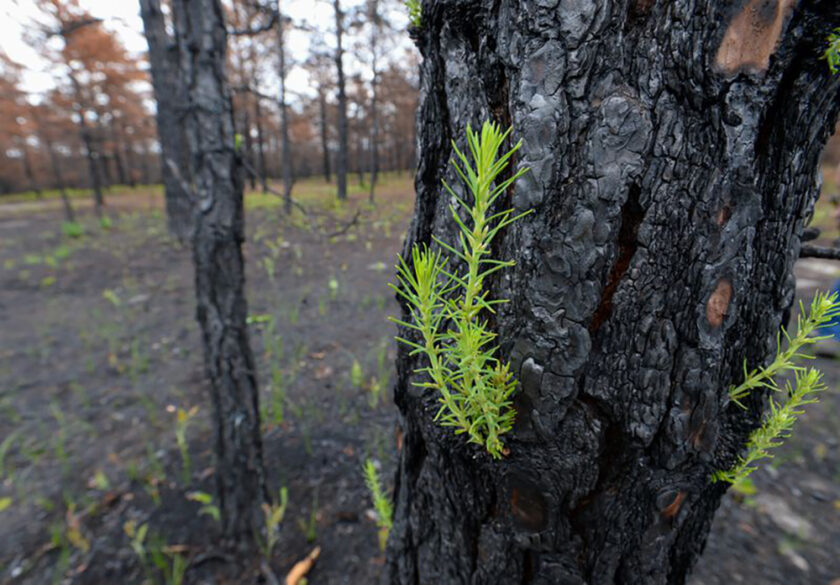By Sarah Fertsch
Staff Writer
On June 18, 2022, an illegal campfire sparked a wildfire that burned over four days. More than 13,500 acres went up in flames, sending smoke tens of miles away to beach towns like Atlantic City.
This historic fire, known today as the Mullica River Wildfire, ranks as the 17th largest forest fire in New Jersey history. It forced 50 people to evacuate the two campgrounds close to the fire. Hundreds of protected pine trees and an unknown number of animals were negatively impacted by the blaze. People in towns miles away, especially those with respiratory conditions, were urged to stay inside to avoid the smoke.
Fire crews battled the blaze 24/7, struggling to contain the inferno amid low-humidity, high-wind conditions. A second wildfire broke out July 12, less than a month after the initial burn.
According to nj.com, it cost an estimated $1 million to fight the fire. An investigation is under way to find and charge those responsible for the illegal Father’s Day campfire that started it all.
Rob Auermuller, Wharton State Forest superintendent, tried to put the scope of one of New Jersey’s biggest wildfires in recent years into perspective.
“That fire affected 80 miles of hiking trails and biking trails, 15 miles of our river systems, and completely burned over one of our campgrounds,” Auermuller said.

He warned visitors and residents to consider the consequences of their actions, given that most forest fires are started by humans. “We don’t know if they are accidental or intentional,” he said.
Today, almost two months since the initial fire, the areas of Wharton State Forest that were burned are starting to show signs of rebirth.
Between charred, black pine trees, little green sprouts are shooting up from the ground. Tree carcasses have become vessels for new plants, and birds are singing across the forest, signaling a return of creatures to their old home.
Greg Pope, a professor of environmental science at Montclair State University, says these pines need regular forest fires to regenerate and stay healthy.
“This forest is like a phoenix,” said Pope. “It’s eternal because every couple of decades, fire helps it become reborn.”
Pope explained that forest fires burn underbrush and dead organic matter. When too much decay blocks new plants from sprouting from the forest floor, a controlled burn becomes necessary to clear the area and unlock nutrients for creatures like worms that live below the surface.
“The Mullica River Fire allows us to look at wildfires more closely and examine the wonder of life rising from the ashes, literally,” he said.
Like hunting, forest fires serve as population resets. Overgrowth of trees, even in a state park, can crowd an ecosystem and lead to too many organisms fighting for limited resources like sunlight or water. As trees become more mature, they require more water, further drying out their neighbors. A forest fire every 50 years is considered healthy, according to Pope.
Rare butterflies and other insect species require a certain amount of sunlight to thrive, so when too many trees are competing for sunlight in a forest, these populations can die out. Some experts predict that without regular forest fires, the Pinelands as we know it would cease to exist.
Surprisingly, animal casualties from wildfires are low native animals survive by burrowing into the ground or fleeing to safer areas. Conversely, fires can help rid an ecosystem of invasive species that have not adapted to regular wildland fires. While animals and plants within dry, forested ecosystems have adapted to thrive within a cycle of wildfires, invasive plants and animals are less likely to recover and could thus be controlled or even eradicated in that area.
Caryn Shinske, the press officer for the state Department of Environmental Protection, said that the fire caused two historic villages and nearby campgrounds to close. Thankfully, in the past month, all villages and campgrounds are open to the public again.
“The New Jersey Pinelands is a fire-adapted ecosystem. The extreme heat from wildfires allows pinecones to open, spreading seeds throughout the forest. Without wildfires, this area would not be dominated by pines and would likely consist of more hardwood trees,” said Shinske. “Pitch pine, the dominant tree species in Wharton State Forest, is resilient and adapted to wildfire. Epicormic buds have already begun resprouting new growth from pitch pine trees throughout the forest.”
While forest fires have existed since the beginning of time as a natural occurrence, climate change is playing a pivotal role in the frequency and intensity of forest fires today. Nationwide, the forest fire season takes place between June and August, but fire towers are reporting wildfires as early as February.
In 2021, the U.S. Environmental Protection Agency published a report stating that the 10 years with the largest acreage burned through wildfires in the country have all taken place since 2004.
“Multiple studies have found that climate change has already led to an increase in wildfire season length, wildfire frequency, and burned area,” reads an excerpt from the report. “The wildfire season has lengthened in many areas due to factors including warmer springs, longer summer dry seasons, and drier soils and vegetation.”
When they do happen, Pope explained that it’s important to use the right firefighting techniques to minimize the potential for property damage and loss of life.
“The key is control,” said Pope.
To combat the rising threats of wildfires, fire departments are using a variety of methods to preserve acres of land. For the recent fire, forest officials said they employed tactics such as controlled burns that can create barriers to slow down wildfires and by using “fuel breaks” — strips or blocks of vegetation or other materials used to divert fires or protect certain areas.
In the case of Wharton State Forest, one proactive measure is the creation of a 5-mile stretch of road carved into the landscape known as the Washington Turnpike project.
This year marks the 78th anniversary of the introduction of Smokey Bear, a friendly woodland creature who offers fire safety tips to children and adults alike. Smokey warns us that 85 percent of forest fires are caused by humans. Because we create it, we must squelch it.
Although nature rebounds with force after every fire, reducing our man-made impacts will benefit every creature on our planet. Understanding forest fires helps keep us safe and better in touch with the world around us.
Sarah Fertsch was born and raised in Egg Harbor Township, and holds a dual degree in public relations and political science. Prior to joining Shore Local full-time, she worked at a CSPAN affiliate, writing about Pennsylvania legislation. When she isn’t writing, Sarah enjoys painting, horseback riding, and Crossfit.










